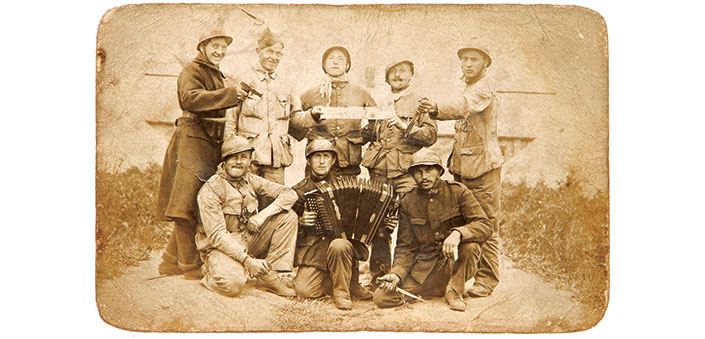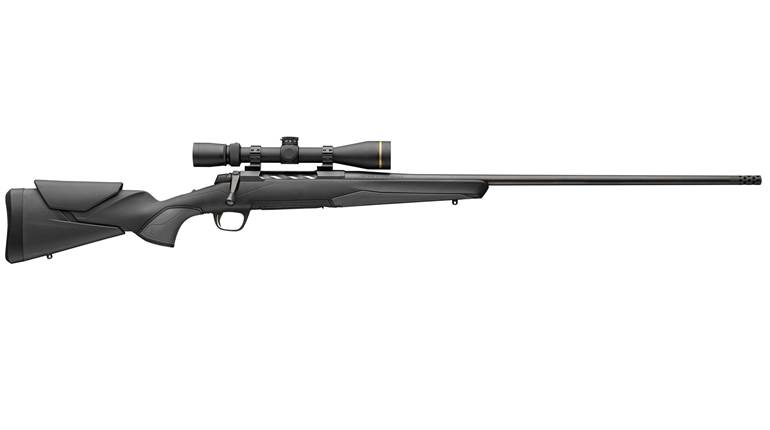
Handguns relating to World War I French and Belgian “trench sweepers“ include (clockwise from top): a factory engraved FN Browning 1900 pistol as used by the French; a French-used FN Browning 1900; a Colt M1911 made in 1918; a Belgian Colt 1903 in original finish; an arsenal refinished Belgian Colt 1903; and Spanish Ruby pistol as used by the French.
In August 1914, German forces crossed into Belgium and France. Their objective was to reach Paris with unprecedented speed and outflank the French army by sweeping through Belgium. Almost immediately, the Germans encountered unforeseen resistance from the Belgians that jeopardized the Schlieffen Plan. The Germans, using their overwhelming manpower, managed to push forward into Belgium. The French, British and Belgians relied heavily on delaying tactics to gain the time needed to mass their troops and halt the German advance. The Germans met their first defeat within sight of Paris, as they underestimated the French Sixth Army and the British Expeditionary Force (BEF) at the Marne. From September 1914 on, the Allies and the Germans raced westward toward the North Sea, trying to outflank one another before the stalemate of trench warfare set in. By the time the front stabilized, the Germans had conquered most of Belgium and parts of northern France, both of which were heavily industrialized areas. In December 1914, the French and Belgian forces took stock of the state of their forces, their equipment and supplies; the results were grim. Troops were exhausted, equipment was worn and in short supply, and logistics were problematic. At first, the depleted Belgians relied on the French for arms, munitions and materiel. This proved to be a mistake, as the French could barely supply themselves.
A Shortage Of Handguns
Fabrique Nationale’s first production pistol was the John Browning-designed Model 1899, and the Belgian military adopted a variant of that gun as the Model 1900. By 1914, it was the only pistol in use by the Belgian military and was known for its reliability and durability. Because FN had been overrun and no new arms were available, the Belgian government wisely turned to England and the United States.

Rifles and carbines were made in England and the United States, and Colt was approached for machine guns and pistols. The Belgians insisted on the reliability of the Browning designs and purchased .32 ACP Colt Model 1903 pistols as the ammunition was readily interchangeable with the FN Browning 1900 pistols already in service. Both pistols were designed by John Browning; the FN Model 1900 pistol originating from an 1896-1897 design and the Colt Model 1903 from a 1901 design.
While the Belgians purchased pistols across the pond, the French turned primarily to Spain, more specifically the Basque region around the city of Eibar. France looked at the Spanish “Star” (a trademark of the Bonifacio Echevarria company) and “Ruby” (a trademark of the Gabilondo y Urresti company) pistols to alleviate their shortages. These were inexpensive and easily obtained. Foreign purchases alleviated pressure on the French domestic industry, which prioritized the manufacture of more vital arms.

Unlike the Belgians, who focused on purchasing one pistol model, the French bought and used just about anything they could get their hands on. As such, a myriad of handguns were used by the French throughout the war, including older 8 mm French revolvers, Spanish 8 mm revolvers and Spanish Ruby and Star pistols. In desperation, the French Purchasing Commission further acquired Savage 1907 pistols, Colt M1911 pistols and Colt Army Special .38 revolvers.
The French and Belgians also made attempts at obtaining arms from the commercial market and private citizens. The Belgians were even so bold as to smuggle pistols from their occupied land to the free Belgian forces. Most often, these guns had been removed from the Liège area factories at the time of the German invasion. The city of Liège, as the center of the Belgian arms industry, had suffered greatly in the first days of the war. Belgian armsmakers sent many of their employees home with as many guns as they could carry in order to avoid seizure by the invader. The guns were hidden in homes throughout the city. Many area armorers made their way to the Belgian free zone in order to work for the war effort, while other patriots worked as smugglers carrying not only arms but also tools, plans and even machinery.

The “Trench Sweepers”
All armies used “trench sweepers” in order to clear captured enemy trenches. The French and Belgian called them Nettoyeurs de Tranchées or “trench cleaners.” The French also called them Zigouilleurs, a term in Argot, a common French dialect, denoting “killers.” These daring men were usually volunteers. The work was extremely hazardous and odds of survival were slim. Most volunteers in these units were not afraid of hand-to-hand combat. They were resourceful and knew the front intimately, including the surrounding land and the maze of trenches. Their task was not limited to clearing the trenches after a successful advance: It also included raids to gather intelligence or capture an enemy soldier. Although the fighting was perilous, these French and Belgian volunteers enjoyed perks that few others had. They were most often exempt from fatigue chores or duties such as filling sand bags, repairing and draining trenches and installing or repairing barbed wire in no-man’s land. The French and Belgian trench sweepers often operated independently. Their orders were given, but the planning and execution of their tasks were left almost entirely up to them. Although they may have had an assigned leader, he was most often a non-commissioned officer. Those that volunteered often felt more in control of their own destiny. While facing the enemy, they relied upon themselves and their own skills for survival. Trench sweepers did not participate in frontal assaults and usually did not face the enemy’s machine guns on open ground like the common foot soldiers.
Another perk for the volunteer trench sweepers was the freedom to select and use their own arms. Long guns had proven early on to be cumbersome and ineffective. Instead, a trench sweeper carried a bag with three or more grenades, a trench knife and a pistol.

French Zigouilleurs
The little that is known about French trench sweepers indicates that they all used pistols. Although France never adopted the Browning 1900 as a military sidearm, the pistol soon became known for its reliability under adverse conditions. The relatively few FN Browning 1900s in French service during the war were either ex-Belgian military pistols or those collected from civilians or the commercial market. Those obtained from the commercial market often bear the retailer’s stamp and a French number near the magazine well. The significance of this number is unknown and is often disputed among collectors.
The FN 1900 was a hot commodity among French sweepers. If they were not available, the French used select Ruby pistols. The Spanish Ruby had only one advantage over the FN 1900 —its magazine held nine rounds instead of seven. Early Rubys were of decent quality but, as the war progressed, Spanish armsmakers started subcontracting, and quality and reliability suffered greatly. Some Rubys had an expected life span of only 500 rounds. The French quickly marked each pistol and all magazines with a two-letter code, which indicated the manufacturer. This avoided problems as the magazines and parts were generally not interchangeable. French sweepers using the Ruby must have selected those pistols that were better built. The Ruby is notoriously heavy, but the added bulk was necessary to compensate for the soft steel the Spanish used in manufacturing.

Interestingly, the Ruby was derived from the FN Browning 1905 Vest Pocket and not the FN Browning 1903 as often suggested. It embodies a simplified FN Browning 1905 mechanism, while the barrel resembles that of the Colt 1903. The Vest Pocket was initially copied in Spain in .25 ACP and later enlarged to the Ruby-sized .32 ACP pistol. The design was illegally copied, and no royalties were ever paid to John Browning or FN, which owned the European manufacturing rights.
The French also purchased Colt M1911 pistols, which were distributed among the first tank battalions, but it is not known if any were used by trench sweepers.
Belgian Nettoyeurs de Tranchées
Belgian trench sweepers never had to worry about the quality of their pistols; they used either the FN Browning 1900 or the Colt 1903. The FN Browning 1900s were mostly remnants of the pre-war Belgian military inventory. Under pre-war agreements, Colt was prohibited from selling Browning pistol designs in Europe, so the sales and manufacturing agreement between John Browning, Colt and FN was suspended during the war. Colt provided the Belgian government with 24,002 Colt Model 1903s between June 1915 and February 1917.
Belgian Colt 1903 contract pistols are found in the 165854 to 241966 serial number range, and they all feature a small diamond letter “A” acceptance marking on the frame. This marking was applied at Colt and is a typical Belgian military acceptance stamp as used by Belgian inspectors at various arms factories. The arsenals were also making holsters for the newly acquired Colt pistols; here again holsters show various leather types. The holster closure hardware, however is always identical.
A rare 1915 Belgian photograph shows one trench sweeper holding a Colt 1903 pistol, and on his belt is a wartime holster, while two trench sweepers hold Belgian trench knives of typical design and another holds a captured German bayonet. The white uniforms are not combat uniforms but typical Belgian work clothing. The accordion is a reminder that these men were often known as adventurers and often referred to as bon vivants (men who enjoy life).
John Moses Browning
After America entered the war, the John Browning-designed Colt Model of 1911 pistol was used by trench sweepers. It did not take long, however, before the Doughboys changed trench sweeping by introducing the Winchester Model 1897 shotgun. It should be no surprise that this, too, was a John Browning design. Whenever men relied on their arms for their lives, either before or after World War I, they chose designs inspired by the genius of John Browning.





































